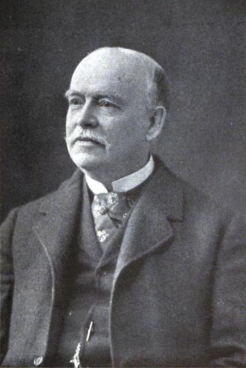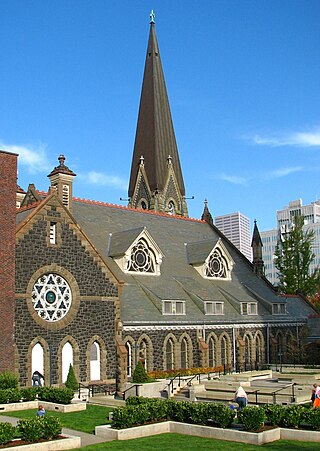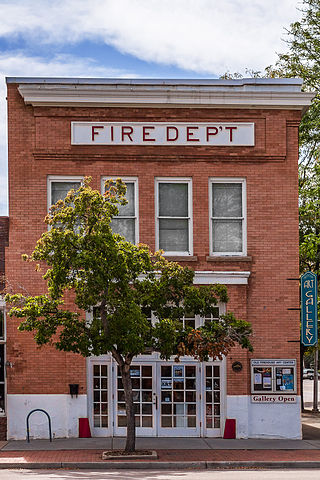
Longmont is a home rule municipality located in Boulder and Weld counties, Colorado, United States. Its population was 98,885 as of the 2020 U.S. Census. Longmont is located northeast of the county seat of Boulder. Longmont is named after Longs Peak, a prominent mountain named for explorer Stephen H. Long that is clearly visible from Longmont, and "mont", from the French word "montagne" for mountain.

Berthoud is a Statutory Town located in Larimer and Weld counties, Colorado, United States. The town population was 10,332 at the 2020 United States Census with 10,071 residing in Larimer County and 261 residing in Weld County. Berthoud is situated north of the Little Thompson River, 21 miles (34 km) south of Fort Collins and 43 miles (69 km) north of Denver in the Front Range Urban Corridor.

Josiah Cleaveland Cady or J. Cleaveland Cady, was an American architect known for his designs in Romanesque and Rundbogenstil styles. He was also a founder of the American Institute of Architects.

The Wyoming State Capitol is located in the city of Cheyenne. Cheyenne is the seat of government for the U.S. state of Wyoming. Built between 1886 and 1890, the capitol is located in Cheyenne and contains the chambers of the Wyoming State Legislature as well as the office of the Governor of Wyoming. It was designated a U.S. National Historic Landmark in 1987. The Capitol underwent an extensive three-year renovation and reopened to the public on July 10, 2019.

Coorparoo is a suburb in the inner City of Brisbane, Queensland, Australia. In the 2021 census, Coorparoo had a population of 18,132 people.

Hygiene is an unincorporated community with a U.S. Post Office in Boulder County, Colorado, United States. Application for the first Hygiene Post Office was made by Jacob Stoner Flory of the United Church of the Brethren on May 28, 1883. Originally named Pella, the community's present name stems from a time when it had a sanatorium to work with tuberculosis patients. St. Vrain Church of the Brethren, a historic Church of the Brethren congregation, is located in the town.

St. Stephen's Episcopal Church, 1881 is a historical church building in Longmont, Colorado. Also known to be middle of Longmont, Colorado back when it started to develop.

The First Presbyterian Church is a church building located in downtown Portland, Oregon, that is listed on the National Register of Historic Places. Construction began in 1886 and was completed in 1890. The building has been called "one of the finest examples" of High Victorian Gothic architecture in the state of Oregon. It includes stained-glass windows made by Portland's Povey Brothers Art Glass Works and a church bell cast with bronze from captured Civil War cannons.

Burnham Hoyt was a prominent mid-20th-century architect born in Denver, Colorado.

The Longmont Fire Department Station 1 is a former fire station in Longmont, Colorado, United States. Constructed in 1907, it remained in use as a fire station until 1971. The fire station is owned by the City of Longmont but is now leased to the Firehouse Art Center.

The Old Stone Congregational Church, also known as the First Congregational Church of Lyons, is a historic church in Lyons, Colorado, built in 1894-5 and listed on the National Register of Historic Places in 1976.
Frederick Albert Hale was an American architect who practiced in states including Colorado, Utah, and Wyoming. According to a 1977 NRHP nomination for the Keith-O'Brien Building in Salt Lake City, "Hale worked mostly in the classical styles and seemed equally adept at Beaux-Arts Classicism, Neo-Classical Revival or Georgian Revival." He also employed Shingle and Queen Anne styles for several residential structures. A number of his works are listed on the U.S. National Register of Historic Places.
Merrill H. Hoyt was a prominent American architect, business man and leader in the building design community of Denver, Colorado from 1910 to 1933.
Eugene G. Groves (1883–1967) was an American architect of Denver, Colorado. He was responsible for the design of civic and educational facilities throughout Colorado over a career spanning five decades.

Charles Sumner Sedgwick was an American architect based in Minneapolis, Minnesota.

Arnett-Fullen House also known as the Gingerbread House, is located on 646 Pearl Street in Boulder, Colorado and is on the list of the National Register of Historic Places listings in Boulder County, Colorado since 2009. This house features a mixture of architectural styles and is a two-story, private residency, which is sometimes open to the public.

The Dickens Opera House, at 302 Main St. in Longmont, Colorado, was built in 1881 and expanded in 1905. It was listed on the National Register of Historic Places in 1987, and was included as a contributing building in the 2017-designated Downtown Longmont Historic District.

The Downtown Longmont Historic District, in Longmont, Colorado, is a historic district which was listed on the National Register of Historic Places in 2017.

The Longmont Carnegie Library, at 457 Fourth Ave. in Longmont, Colorado, is a Carnegie library which was completed in 1913. It was listed on the National Register of Historic Places in 1992, and was included as a contributing building in the Downtown Longmont Historic District in 2017.

The T. M. Callahan House, also known as the ‘’’Sweeny-Callahan House’’’, at 312 Terry St. in Longmont, Colorado, is a large Queen Anne-style house built in 1892 and expanded in 1897 and 1908. It was listed on the National Register of Historic Places in 1985.



















